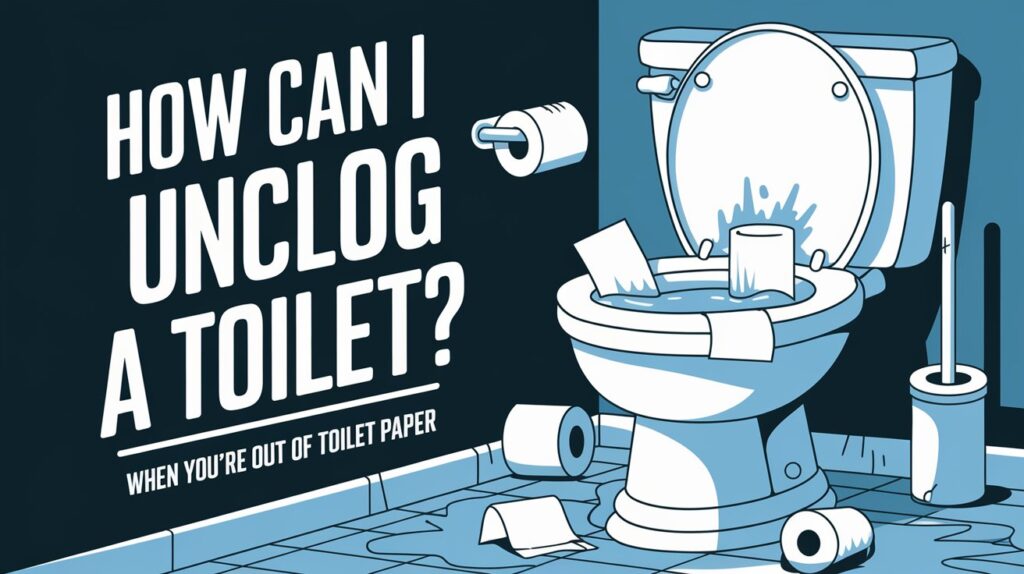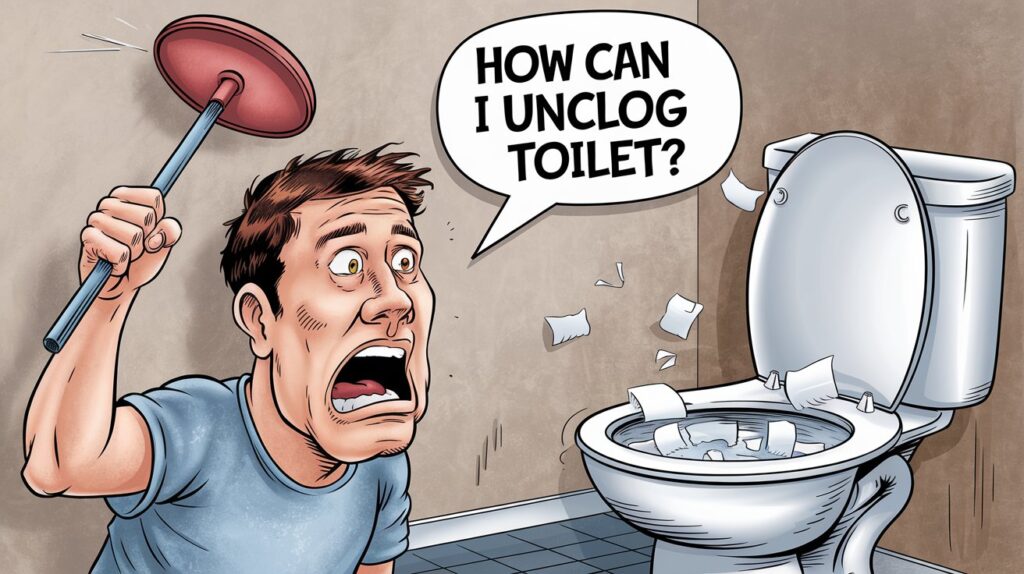Plumbers Tweed Heads Near You in 2025
Media

DIY Summary On How Can I Unclog a Toilet?
How Can I Unclog a Toilet? Effectively unclog your toilet using a plunger, dish soap and hot water, baking soda and vinegar, or a toilet auger with our comprehensive step-by-step guide. Discover preventive measures to avoid future blockages and understand when it’s necessary to call a professional plumber. Additionally, find answers to common questions and learn about the underlying causes of toilet clogs to keep your bathroom running smoothly.
Why You Are Here?
A clogged toilet is an all-too-common household issue that can cause significant inconvenience and stress. Whether it’s due to a sudden overflow or a slow drain, knowing how to unclog a toilet effectively is essential for maintaining a clean and functional bathroom. In this comprehensive guide, we’ll explore the causes of toilet clogs, provide step-by-step methods to resolve them both with and without tools, and offer tips to prevent future blockages. By the end, you’ll be equipped with the knowledge to tackle this problem confidently.
Introduction How Can I Unclog a Toilet?
The Common Problem of Clogged Toilets
Clogged toilets are a frequent household nuisance that can disrupt daily routines and create unsanitary conditions. Whether it’s caused by excessive toilet paper, non-flushable items, or underlying plumbing issues, a blocked toilet requires prompt attention to restore normal functionality.
Importance of Addressing Clogs Promptly
Ignoring a clogged toilet can lead to more severe problems, including water damage, unpleasant odors, and potential health hazards. Additionally, persistent clogs may indicate deeper plumbing issues that could require costly repairs if left unattended.
Promise of Practical Solutions
This blog aims to provide practical, step-by-step solutions for unclogging a toilet using both common household items and specialized tools. Whether you’re a DIY enthusiast or prefer seeking professional help, you’ll find valuable insights to resolve toilet clogs effectively.
Understanding the Causes of Toilet Clogs
Excessive Toilet Paper Use
One of the most common reasons for a clogged toilet is the overuse of toilet paper. Flushing large quantities can overwhelm the plumbing system, especially in older homes with narrower pipes. It’s essential to use toilet paper sparingly and flush multiple times if necessary to prevent blockages.
Non-Flushable Items
Items such as wipes (even those labeled “flushable”), feminine hygiene products, toys, and paper towels should never be flushed down the toilet. These objects do not break down easily and can accumulate in the pipes, leading to significant blockages.
Plumbing Issues
Sometimes, clogs are not due to user habits but rather underlying plumbing problems. Tree roots invading the drainage system, broken or collapsed pipes, and other structural issues can obstruct the flow of waste, making toilets prone to frequent clogs.
Low-Flow Toilets
Older or water-saving toilet models may not provide enough force during flushing to clear waste effectively. This can result in frequent clogs, especially when combined with excessive toilet paper use or the presence of non-flushable items.
Essential Tools and Materials
Before attempting to unclog your toilet, gather the following tools and materials to ensure a smooth and efficient process:
- Plunger: Opt for a flanged plunger for better suction and a ball-shaped plunger for standard toilets.
- Dish Soap and Hot Water: These household staples can help lubricate and break down blockages.
- Baking Soda and Vinegar: A natural cleaning duo that can dissolve organic matter.
- Toilet Auger (Snake): A specialized tool designed to reach deeper clogs within the toilet’s plumbing.
- Wet/Dry Vacuum (Optional): Useful for stubborn clogs that resist other methods.
- Rubber Gloves and Cleaning Supplies: Protect your hands and maintain hygiene while working on the toilet.

Step-by-Step Methods to Unclog a Toilet
1. Using a Plunger
Step 1: Choose the Right Plunger
Select a plunger with a flange (a narrow extension on the bottom) designed specifically for toilets. This type ensures a better seal and more effective suction.
Step 2: Position the Plunger
Place the plunger into the toilet bowl, ensuring it covers the drain opening completely. The flange should fit snugly around the hole to create maximum suction.
Step 3: Plunge Correctly
Start with slow, controlled plunges to push water into the drain. After a few gentle pushes, switch to more vigorous up-and-down movements to create pressure that dislodges the clog.
Step 4: Check for Success
After several plunges, remove the plunger to see if the water drains away. If it does, the clog has been cleared. If not, repeat the process a few more times.
Troubleshooting:
If plunging doesn’t work, consider using a toilet auger or trying alternative methods outlined below.
2. Dish Soap and Hot Water Method
Step 1: Add Dish Soap
Pour about a cup of dish soap into the toilet bowl. Allow it to sit for 10-15 minutes to lubricate the clog.
Step 2: Heat the Water
Heat a gallon of water on the stove until it’s hot but not boiling. Boiling water can crack porcelain toilets.
Step 3: Pour the Water
Carefully pour the hot water into the bowl from waist height to create force. Let it sit for another 10-15 minutes.
Step 4: Flush
Attempt to flush the toilet. If the water drains properly, the clog has been cleared. If not, repeat the process once more.
3. Baking Soda and Vinegar Reaction
Step 1: Add Baking Soda
Pour one cup of baking soda into the toilet bowl.
Step 2: Add Vinegar
Follow with two cups of vinegar. The mixture will start to fizz and bubble, working to break down the clog.
Step 3: Let It Sit
Allow the mixture to sit for about 30 minutes to maximize its effectiveness.
Step 4: Add Hot Water
Pour hot water (not boiling) into the bowl to help flush away the dissolved blockage.
4. Toilet Auger (Snake)
Step 1: Insert the Auger
Feed the toilet auger into the drain until you feel resistance, indicating the presence of the clog.
Step 2: Twist and Push
Twist the auger handle while gently pushing forward to break through or latch onto the blockage.
Step 3: Retrieve the Auger
Slowly pull the auger back, bringing the clog with it. Dispose of any debris appropriately.
Safety Tips:
- Avoid using excessive force to prevent damaging the porcelain.
- Clean the auger thoroughly after use to maintain hygiene.
5. Alternative Methods
Using a Plastic Bottle:
Fill a large plastic bottle with water and quickly invert it, forcing water into the drain to create pressure that can dislodge the clog.
Wet/Dry Vacuum Technique:
If available, use a wet/dry vacuum to suck out the blockage. Ensure the vacuum is set to liquid mode and create a tight seal around the drain.
Bio-Cleaners:
Eco-friendly bio-cleaners containing enzymes can dissolve waste without harming pipes. Follow the manufacturer’s instructions for best results.
6. As a Last Resort: Chemical Drain Cleaners
Risks of Chemical Cleaners:
Harsh chemicals can damage your plumbing, create hazardous fumes, and pose safety risks. Use them only if other methods fail.
How to Use:
Follow the product instructions carefully. Typically, you pour the recommended amount into the bowl, wait for the specified time, and then flush with water.
Caution:
Always wear protective gloves and eyewear when handling chemical cleaners, and ensure proper ventilation.
Preventing Future Clogs
Avoid Flushing Non-Flushable Items
Educate household members to never flush items like wipes, cotton balls, feminine hygiene products, or paper towels. Dispose of these items in the trash instead.
Use Toilet Paper Sparingly
Reduce the amount of toilet paper used per flush. If necessary, flush multiple times to ensure all paper is cleared without overloading the pipes.
Regular Maintenance
Use bio-cleaners or enzyme-based solutions regularly to keep your pipes clear and prevent buildup of organic matter.
Educate Children
Teach children proper toilet use, emphasizing what can and cannot be flushed to prevent accidental blockages.
Address Plumbing Issues Early
If you suspect tree roots or other structural problems in your drainage system, contact a professional plumber promptly to address the issue before it leads to frequent clogs.
When to Call a Professional Plumber
Signs DIY Methods Aren’t Working
If you’ve tried multiple unclogging methods without success, or if clogs recur frequently, it’s time to seek professional help.
Structural Plumbing Issues
Severe blockages caused by tree roots, broken pipes, or significant drainage system problems require the expertise and specialized tools of a professional plumber.
Importance of Professional Tools
Professional plumbers have access to advanced equipment like telescoping augers and hydro jetting machines, which can resolve deep or stubborn clogs effectively without causing damage.

Frequently Asked Questions (FAQs)
How Can I Unclog a Toilet?
Unclogging a toilet can be achieved using several methods:
- Plunging: Use a flange plunger to create suction and dislodge the blockage.
- Dish Soap and Hot Water: Lubricate the clog with dish soap and use hot water to break it down.
- Baking Soda and Vinegar: Utilize the chemical reaction to dissolve organic matter.
- Toilet Auger: Reach deeper blockages with a specialized tool.
- Alternative Methods: Use a plastic bottle or wet/dry vacuum for stubborn clogs.
- Chemical Cleaners: As a last resort, use chemical drain cleaners with caution.
What Causes Toilets to Clog Frequently?
Frequent toilet clogs can be caused by:
- Excessive use of toilet paper.
- Flushing non-flushable items.
- Low-flow toilets not providing enough pressure.
- Underlying plumbing issues like tree roots or broken pipes.
Are Chemical Cleaners Safe for My Plumbing?
Chemical drain cleaners can be harsh on your plumbing, potentially causing pipe damage and creating hazardous fumes. It’s best to use them only as a last resort and follow the manufacturer’s instructions carefully.
How Can I Prevent Future Toilet Clogs?
Prevent future clogs by:
- Avoiding the flushing of non-flushable items.
- Using toilet paper sparingly.
- Regularly maintaining your plumbing with bio-cleaners.
- Educating household members on proper toilet use.
- Addressing any plumbing issues promptly.
When Should I Call a Professional Plumber?
Consider calling a professional plumber if:
- DIY methods fail to unclog the toilet.
- You experience recurring clogs.
- There are signs of structural plumbing issues.
- You need advanced tools or expertise to resolve the problem.
Conclusion How Can I Unclog a Toilet?
Clogged toilets can be a hassle, but with the right knowledge and tools, you can tackle this issue effectively. From simple plunging techniques to using household items like dish soap and baking soda, there are multiple methods to unclog your toilet. Remember to practice preventive measures to minimize the risk of future blockages. However, if the problem persists or involves complex plumbing issues, don’t hesitate to seek professional assistance. Maintaining a functional and clog-free toilet ensures a clean and comfortable bathroom environment for you and your family.
Call Us Today

Affiliate Disclaimer: This post may contain affiliate links. If you click on a link and make a purchase, we may earn a small commission at no additional cost to you.

Leave a Reply